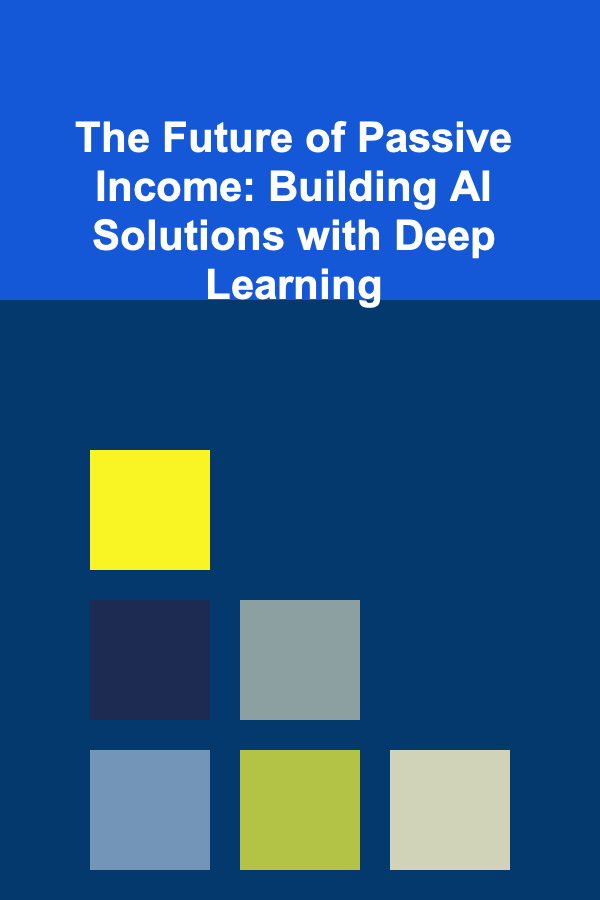
The Future of Passive Income: Building AI Solutions with Deep Learning
ebook include PDF & Audio bundle (Micro Guide)
$12.99$6.99
Limited Time Offer! Order within the next:

In recent years, the concept of passive income has gained significant attention, as people seek to diversify their income sources beyond traditional 9-to-5 jobs. With the rise of technology, especially artificial intelligence (AI) and deep learning, new avenues for passive income have opened up. One of the most promising fields in this regard is leveraging deep learning technologies to build AI solutions that generate recurring revenue with minimal ongoing effort. This article explores how deep learning can be used to create AI solutions that provide passive income, offering insights into the future of this exciting intersection between AI and finance.
What is Passive Income?
Before diving into how AI and deep learning can create passive income opportunities, it's essential to understand what passive income is. Passive income refers to money earned with minimal active involvement once the initial effort has been made. This contrasts with active income, where one must exchange time and effort directly for money, such as in a traditional job or freelancing.
Some of the most common forms of passive income include:
- Royalties from creative work (such as books, music, patents, and digital content).
- Interest from investments like stocks, bonds, and savings accounts.
- Rental income from properties.
- Affiliate marketing, where one earns commissions for promoting third-party products.
The beauty of passive income lies in its ability to generate earnings with little day-to-day involvement once the initial work is done. Deep learning provides a unique opportunity to tap into this model, as it enables the creation of AI-powered systems and solutions that continue to generate revenue over time.
The Role of Deep Learning in Building AI Solutions
Deep learning is a subset of machine learning, where algorithms attempt to mimic the human brain's neural network to learn from vast amounts of data. This powerful technology has already revolutionized industries such as healthcare, finance, and entertainment by enabling machines to perform tasks like image recognition, speech processing, natural language understanding, and autonomous decision-making.
In terms of building passive income, deep learning can be utilized in several innovative ways:
- Developing AI Models: Once trained, AI models can be packaged and sold or licensed to businesses, generating continuous revenue.
- Creating AI-powered Software: AI solutions can be integrated into software products, offering subscription-based models or pay-per-use services that generate ongoing income.
- Educational Content: Experts in deep learning can create courses, tutorials, and books, offering valuable resources to learners while earning passive income from royalties or course fees.
- AI-Generated Content: Leveraging deep learning models to create art, music, or other content allows for monetization through licensing or direct sales.
Let's explore each of these in greater detail, examining how deep learning can be the foundation for building sustainable passive income.
Creating and Selling AI Models
Deep learning models are the cornerstone of many AI applications. These models can solve specific problems, such as classifying images, predicting stock market trends, or processing natural language for chatbots. Once a deep learning model is trained and fine-tuned, it can be packaged and sold or licensed to other companies, allowing the creator to earn passive income from its ongoing use.
AI Marketplaces
One of the most straightforward ways to monetize AI models is through online AI marketplaces, such as Hugging Face, Algorithmia, and Modelplace. These platforms allow developers to upload their models, which can then be accessed or purchased by other businesses. Once a model is listed on these platforms, the creator earns a commission or royalty each time the model is downloaded or used.
For example, suppose you develop a deep learning model that can detect fraudulent transactions in real-time. Companies in the finance industry would likely find this model valuable, as it can be integrated into their security systems. By licensing or selling the model through a marketplace, you can continue to earn revenue every time a company uses it.
Custom Solutions for Enterprises
Another way to monetize deep learning models is by offering custom solutions to businesses. This approach involves developing tailored models that address specific needs within an organization. Once the model is integrated into the company's systems, you can charge licensing fees or subscription-based fees for continued use of the model.
For instance, if you build an AI model that automates customer service through chatbots, companies can pay for access to the model as part of a subscription plan. Over time, as more companies implement AI-powered chatbots, your model could continue to generate revenue.
Building AI-Powered Software Products
Building AI-powered software solutions is another excellent way to generate passive income. These software products can address various problems, ranging from automation of repetitive tasks to advanced data analytics and decision-making.
SaaS (Software as a Service) Models
Software-as-a-Service (SaaS) platforms are subscription-based models that allow users to access software hosted in the cloud. By integrating deep learning models into SaaS platforms, you can build AI-powered solutions that generate recurring revenue through monthly or yearly subscriptions.
For example, a deep learning-based image recognition tool can be integrated into a SaaS platform, allowing users to upload images for automatic tagging or categorization. As the platform grows in popularity, users will pay to access the service on a recurring basis, generating passive income for the creator.
Pay-Per-Use Models
Alternatively, AI solutions can be offered through a pay-per-use model, where users only pay for the services they use. This model is especially effective for services that process large amounts of data or require intensive computation, such as natural language processing or computer vision applications.
For example, an AI-powered text summarization tool could be developed, where users pay for each document they upload for summarization. This model allows the creator to generate income based on usage, with minimal ongoing effort after the system is set up.
Creating and Monetizing Educational Content
The demand for AI knowledge, especially deep learning expertise, continues to grow. By creating educational content, you can monetize your knowledge and generate passive income. There are several platforms where you can publish courses, books, and tutorials, earning royalties, course fees, or other revenue sources.
Online Courses
Platforms like Udemy, Coursera, and Skillshare offer an excellent way for deep learning experts to create and sell courses. Once the course is created and uploaded, it can be sold to a global audience, providing you with a steady stream of income.
For example, you could create a deep learning course that covers topics like building neural networks, working with datasets, or deploying AI models. As students purchase the course, you earn a portion of the revenue, generating passive income over time.
E-Books and Guides
In addition to online courses, deep learning experts can write and sell e-books or guides. These resources can be sold on platforms like Amazon, providing a source of passive income from book royalties. E-books can range from beginner-friendly introductions to deep learning to more advanced texts that focus on niche topics within the field.
YouTube and Blogs
Creating a YouTube channel or blog dedicated to deep learning can also be an excellent way to generate passive income. Through monetization methods such as ad revenue, sponsorships, and affiliate marketing, you can earn money as your content attracts views and traffic.
For example, you could create a YouTube channel where you teach viewers how to build deep learning models from scratch. As your channel grows in popularity, you can earn money through ads, partnerships, and promotions. Similarly, writing blog posts or tutorials can attract traffic and generate income through affiliate links or sponsored content.
Monetizing AI-Generated Content
Another exciting opportunity for passive income lies in the world of AI-generated content. Deep learning models, such as Generative Adversarial Networks (GANs), have the ability to create unique art, music, and even written content. These digital assets can be monetized through various channels, providing another passive income stream.
Selling AI-Generated Art as NFTs
Non-fungible tokens (NFTs) have revolutionized the way digital art is bought and sold. AI-generated art can be sold as NFTs on platforms like OpenSea, Rarible, and Foundation. The process is simple: once the artwork is created, it is uploaded to a blockchain platform and tokenized as an NFT. When the artwork is sold, the creator can earn a percentage of the sale, and some platforms even offer royalties on future resales.
For example, using deep learning models like GANs, you can create digital paintings, illustrations, or abstract artwork. By listing these pieces as NFTs, you can earn money each time someone buys or resells them.
Licensing AI-Generated Music
AI models can also generate music, opening up opportunities for passive income. Once an AI model has been trained to create music, the generated tracks can be licensed to media outlets, game developers, and content creators. Licensing platforms like Audiojungle or Epidemic Sound allow creators to earn royalties each time their music is used in videos, advertisements, or films.
Stock Photo Sites
AI-generated images can be sold through stock photo websites like Shutterstock or Adobe Stock. Once the images are uploaded, they can be licensed to businesses, marketers, and designers. Every time one of your images is downloaded or purchased, you earn a royalty.
The Future of Passive Income with AI and Deep Learning
As AI and deep learning technologies continue to evolve, the opportunities for generating passive income will only increase. With the rise of more accessible platforms for building and selling AI solutions, the barriers to entry are lower than ever. Whether through AI models, software products, educational content, or AI-generated art, there are countless ways to create systems that generate passive income.
AI-Driven Automation and Integration
As AI systems become more sophisticated, automation will play a central role in minimizing ongoing effort. AI solutions can automate repetitive tasks, optimize processes, and integrate seamlessly with other platforms, making them even more attractive for businesses and consumers alike. This automation will continue to drive passive income generation with less involvement from the creator.
Ethical Considerations and Sustainability
While the potential for passive income through AI is immense, it is important to consider the ethical implications of AI development. As AI solutions become more integrated into society, questions around data privacy, bias in models, and the environmental impact of AI must be addressed. Building ethical AI solutions will be key to ensuring the sustainability of this model for long-term passive income.
Conclusion
The future of passive income is intertwined with the rapid development of AI and deep learning technologies. By leveraging deep learning to create AI models, software products, educational content, and digital assets, creators can tap into a growing market and generate recurring revenue with minimal ongoing effort. The opportunities are vast, and as AI technologies continue to evolve, so too will the potential for passive income. The key to success lies in creating valuable, scalable solutions that can work for you while you focus on other pursuits.

How to Effectively Use a Schwab Personal Choice Retirement Account
Read More
How to Light Your Home for Maximum Productivity
Read More
How to Plan a New Year's Eve Party at Home
Read More
How to Save Space in Your Bedroom with Smart Furniture Choices
Read More
How to Read Nutrition Labels for Added Sugars
Read More
10 Tips for Building a Cohesive Color Palette in Collage
Read MoreOther Products

How to Effectively Use a Schwab Personal Choice Retirement Account
Read More
How to Light Your Home for Maximum Productivity
Read More
How to Plan a New Year's Eve Party at Home
Read More
How to Save Space in Your Bedroom with Smart Furniture Choices
Read More
How to Read Nutrition Labels for Added Sugars
Read More